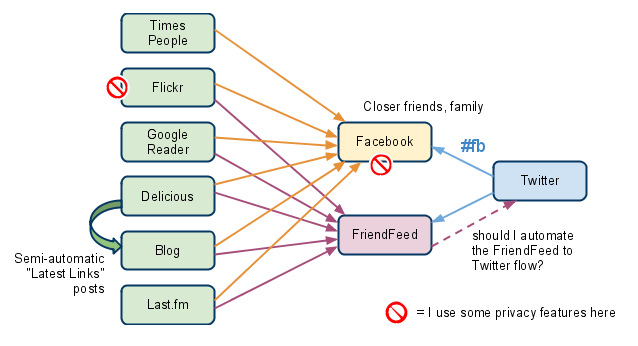« BarCampRDU | Main | ApacheConUS 2009... »
Social data flow
(Note that I wrote this over weekend, before we all learned about Facebook acquiring FriendFeed. It's hard thinking about how things will change because we have no idea what Facebook will do with FriendFeed, but I'm guessing that this acquisition will end-up making Google Reader a more central part of my flow.)
Every time I find something that I want to share with others online, I have to think about how I want to share and whom I want to share it with. Perhaps I've created too much complexity for myself. This diagram below illustrates the situation. It's my social data flow diagram. Take a look and then I'll explain.

The diagram
The boxes are web sites and the arrows indicate data that flows automatically between those sites. I think of the sites on the left as source sites, places where I share blog entries, post photographs, tag interesting articles and indicate that I like specific songs. The sites in the middle are aggregation sites. Things I share on my source sites are aggregated together so that my Facebook and FriendFeed friends see the things that I do on those source sites and make comments.
Different audiences
I treat Facebook and FriendFeed differently. I try to be Facebook "friends" with only people that I know and trust. I feel more free to share some personal things there; family news, political views, etc. because, in theory, only my good friends can see them. For some reason, I'm leery of Facebook and I don't feel like committing too much information to them. For example, I'd rather upload photos to Flickr. That's one of reasons I share on other sites like FriendFeed, Twitter and Delicious.
FriendFeed, on the other hand, I treat as totally public. Everybody can see what I post there and I'll follow people I don't know so well. In fact, everything I do except for Facebook and some Flickr photos is public. This brings me to the topic of Twitter.
Reducing complexity
Since I'm a geek, I don't mind a little complexity. The one part of my flow that I would like to simplify is link sharing. I use Google Reader heavily but when I want to share a link, I feel that I need to post it over to Delicious because I've got a wealth of links there and infrastructure in place to send daily "Latest Links" post over to my blog. Now that Reader has made it so easy to share, tag and comment on links I'm considering dropping Delicious and doing all of my sharing through Reader. Another thing I'm considering is a little more automation.
Automate everything?
To me, Twitter is like a huge public chat-room where you only have to listen to the people you want to listen to. All of my tweets are automatically posted to my FriendFeed account. Because of the chat-room nature of Twitter and the fact that many of my Facebook friends don't understand Twitter, I don't like automatically pumping my entire Twitter stream into Facebook. I use Facebook Application callled Selective Twitter so that only tweets that include the string "#fb" go to Facebook.
I don't like automatically pumping things into Twitter either. I often re-share things that I have shared on my blog by posting them to Twitter, usually using a URL shortening service (bit.ly) because tweets must be short (max ~140 characters). This is not an automatic process and I do it only for specific things that I want to share and comment about on Twitter.
Question is: should I automate the flow between FriendFeed and Twitter? If I did so, my Twitter followers would see a tweet every time I share something on any of my source sites. That would be good, right? The conventional social media wisdom for success on Twitter seems to be that you should ABC or "always be linking." Sounds a little slutty, sure, but there is something to that approach: the more you share, the better your chances of connecting with interesting people. I haven't done it yet because I worry that it's too spammy in a chat-room like setting.
Dave Johnson in Social Software
12:52PM Aug 10, 2009
Comments [2]
Tags:
blogging
facebook
friendfeed
googlereader
socialnetworking
twitter
« BarCampRDU | Main | ApacheConUS 2009... »
Welcome
This is just one entry in the weblog Blogging Roller. You may want to visit the main page of the weblog
Related entries
Below are the most recent entries in the category Social Software, some may be related to this entry.
- Thoughts on ActivityPub, Mastodon, etc.
- Apache Rave: A new social mashup engine!
- The meaning of the Facebook like button
- Understanding Google's new privacy policy
- Scott McNealy's Wayin weighs in on the election
- More corporate censorship
- Corporate censorship
- 2011 Tweet Cloud
- re: RDF and OpenSocial
- OAuth and OpenID: take2
Posted by Shane Curcuru on August 11, 2009 at 06:14 PM EDT #
Posted by Mahendra on August 16, 2009 at 03:16 PM EDT #